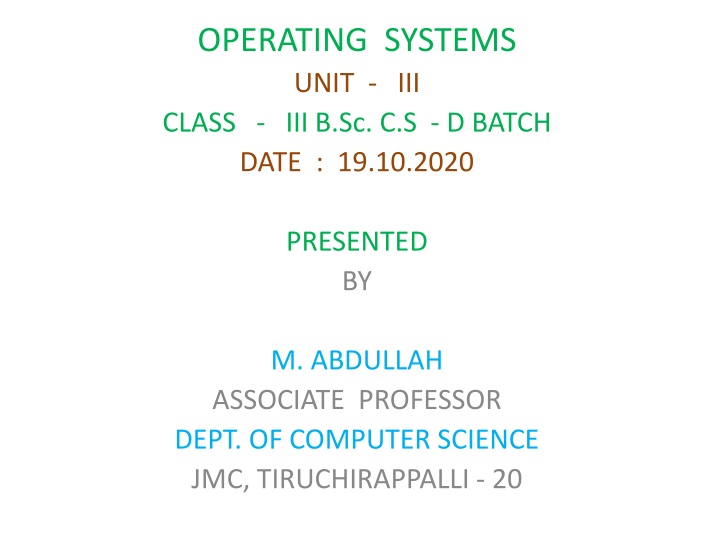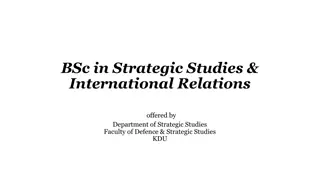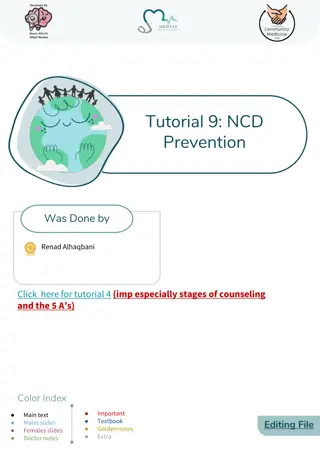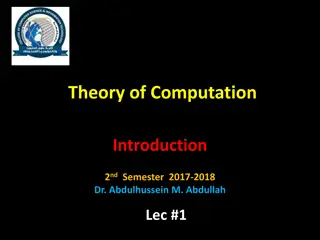
Processor and Job Management in Operating Systems
Learn about processor and job management in operating systems, including processor assignment to processes, job scheduling, process scheduling, and resource allocation. Explore the functions of job scheduler, traffic controller, and processor scheduler in managing system processes effectively.
Download Presentation

Please find below an Image/Link to download the presentation.
The content on the website is provided AS IS for your information and personal use only. It may not be sold, licensed, or shared on other websites without obtaining consent from the author. If you encounter any issues during the download, it is possible that the publisher has removed the file from their server.
You are allowed to download the files provided on this website for personal or commercial use, subject to the condition that they are used lawfully. All files are the property of their respective owners.
The content on the website is provided AS IS for your information and personal use only. It may not be sold, licensed, or shared on other websites without obtaining consent from the author.
E N D
Presentation Transcript
OPERATING SYSTEMS UNIT - III CLASS - III B.Sc. C.S - D BATCH DATE : 19.10.2020 PRESENTED BY M. ABDULLAH ASSOCIATE PROFESSOR DEPT. OF COMPUTER SCIENCE JMC, TIRUCHIRAPPALLI - 20
Processor Management : Processor Management management of the physical processors, specifically, the assignment of processors to processes. The job scheduler, which creates the processes and in a non multi programmed environment, would decide which process is to receive a processor. The processor scheduler multiprogramming environment, decides which of the ready processes receives a processor, at what time and for how long and the traffic controller , which keeps track of the status of the process is concerned with the , which , in a
Job management of jobs, and processor scheduling to concerned with processes. In either case, the processor is the key resource. Job Scheduler: The job scheduler is the super manager, which must Keep track of the status of all jobs . It must note which jobs are trying to get some service and the status of all jobs being serviced(ready, running or blocked state ). scheduling is concerned with the the management of
Choose the policy by which jobs will enter the system( i.e , go from hold state to ready state). The decision may be based on such characteristics as Priority , resources requested , or system balance. Allocate the necessary scheduled job by use of memory, device, and processor management. Deallocate these resources when the job is done. Process Scheduling : Once the job scheduling has moved a job from hold to ready, it creates one or more processes for this job. resources for the
Who decides which processes in the system get a processor, when, and for how long? The process scheduling modules Specifically , the following functions must be performed : Keeping track of the status of the process ( all processes are either running, ready or blocked). The module that performs this function has been called the traffic controller. Deciding which process gets a processor and for how long. This is performed by the processor scheduler. make the decisions.
Allocation of a processor to a process. This requires resetting of processor registers to correspond to the process correct state. This task is performed by the traffic controller. De-allocation of a processor, such as when the running process exceeds its current quantum or must wait for an I/O completion. This requires that all processor state registers be saved to allow future reallocation. This task is performed by the traffic controller.
Structure of Processor Management The three main are job scheduling, process scheduling and synchronization, are all concerned with the assignment of processors to processes. Processor management operates on two levels-assigning processors to jobs and assigning processors to processes. On the job level, processor management is concerned with such questions as which jobs will be run and which will run first. At this first level processor management is not concerned with multiprogramming. It assumes scheduled, it will run. Job scheduling can run concurrently with other programs or other system functions. Thus job scheduling may itself be a separate process. that once a job is users
Once a job is scheduled, the system must perform the functions of creating processes, destroying processes, and sending processes. In a general system these functions may be requested by users processes, job scheduler, and other processes. Thus the functions may be common to all address spaces. In a multiprogramming scheduler and the synchronization mechanisms may be called by all modules of the system. Thus they form the center of the kernel of a system. This model of system structure is the basis for the sample operating system. messages between environment the process
Process Scheduler : Functions : The process scheduler must perform the following functions. Keep track of the state of processes. Decide which process gets a processor, when and for how long. Allocate processors to processes. De-allocate processors from processes. The module of the processor scheduler that performs these functions is called the traffic controller. The database associated with each process in the system is called a process control block(PCB). There is a separate PCB for each process; in fact the PCB is the only really tangible part of a process.
POLICIES : The scheduling policy must decide which process is to be assigned a processor and for how long. The PCB ready list and applying some policy. It can be organized in 2 ways. Each time a process is put on the ready list ,it is put in its correct priority position in order. Processes are arbitrary places on the ready list. TYPICAL PROCESS SCHEDULING POLICIES the following : Round Robin : Each process in turn is run to a time quantum limit, such 100ms. Inverse of remainder of quantum :
If the process used its entire quantum last time. It goes to the end of the list. Multiple level feed back variant on Round Robin.: When a new process is entered , it is run for as many time quantum as all other jobs in the system. Priority : The highest priority ready job is selected it may be purchased or assigned. Limited Round Robin : Jobs are run round robin until some fixed number of times. System Balance : In order to keep the I/O devices busy processes that do a lot of I/O are give preference. Other processor scheduling policies have been discussed in the literature Buzen, 1978 Coffman 1968.
Operating System - Process Scheduling Definition : The process scheduling is the activity of the process manager that handles the removal of the running process from the CPU and the selection of another process on the basis of a particular strategy. Process scheduling is an essential part of a Multiprogramming operating systems. Such operating systems allow more than one process to be loaded into the executable memory at a time and the loaded process shares the CPU using time multiplexing.
Process Scheduling Queues : The OS maintains all PCBs in Process Scheduling Queues. The OS maintains a separate queue for each of the process states and PCBs of all processes in the same execution state are placed in the same queue. When the state of a process is changed, its PCB is unlinked from its current queue and moved to its new state queue. The Operating System maintains the following important process scheduling queues Job queue This queue keeps all the processes in the system. Ready queue This queue keeps a set of all processes residing in main memory, ready and waiting to execute. A new process is always put in this queue. Device queues The processes which are blocked due to unavailability of an I/O device constitute this queue.
The OS can use different policies to manage each queue (FIFO, Round Robin, Priority, etc.). The OS scheduler determines how to move processes between the ready and run queues which can only have one entry per processor core on the system; in the above diagram, it has been merged with the CPU. Two-State Process Model : Two-state process model refers to running and non-running states which are described as follows.
State & Description : Running When a new process is created, it enters into the system as in the running state. Not Running Processes that are not running are kept in queue, waiting for their turn to execute. Each entry in the queue is a pointer to a particular process. Queue is implemented by using linked list. Use of dispatcher is as follows. When a process is interrupted, that process is transferred in the waiting queue. If the process has completed or aborted, the process is discarded. In either case, the dispatcher then selects a process from the queue to execute.
Operating System Scheduling algorithms: A Process Scheduler schedules different processes to be assigned to the CPU based on particular scheduling algorithms. There are three popular process scheduling algorithms. First-Come, First-Served (FCFS) Scheduling Shortest-Job-Next (SJN) Scheduling Round Robin(RR) Scheduling These algorithms are preemptive. Non-preemptive algorithms are designed so that once a process enters the running state, it cannot be preempted until it completes its allotted preemptive scheduling is based on priority where a scheduler may preempt a low priority running process anytime when a high priority process enters into a ready state. either non-preemptive or time, whereas the
First Come First Serve (FCFS): Jobs are executed on first come, first serve basis. It is a non-preemptive, pre-emptive scheduling algorithm. Easy to understand and implement. Its implementation is based on FIFO queue. Poor in performance as average wait time is high.
Wait time of each process is as follows : Proc ess Wait Time : Service Time - Arrival Time P0 0 - 0 = 0 P1 5 - 1 = 4 P2 8 - 2 = 6 P3 16 - 3 = 13
Average Wait Time: (0+4+6+13) / 4 = 5.75 Shortest Job Next (SJN): This is also known as shortest job first, or SJF This is a non-preemptive, pre-emptive scheduling algorithm. Best approach to minimize waiting time. Easy to implement in Batch systems where required CPU time is known in advance. Impossible to implement in interactive systems where required CPU time is not known. The processer should know in advance how much time process will take.
Given: Table of processes, and their Arrival time, Execution time Average Wait Time: (0 + 4 + 12 + 5)/4 = 21 / 4 = 5.25 Execution Time Service Time Process Arrival Time P0 0 5 0 P1 1 3 5 P2 2 8 14 P3 3 6 8






















